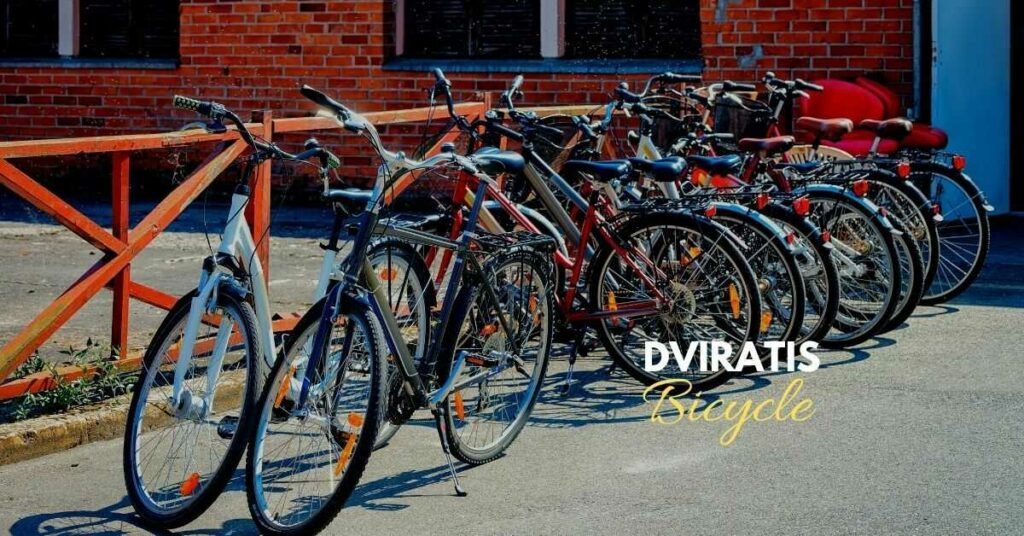Lithuanian public transportation may be slow, but it will make your trip memorable, especially if you know some Lithuanian vocabulary about transportation (Gabenimas). Taking public transportation (Gabenimas) in Lithuania when you go to different will make you learn about their culture and amazing people. Did you know that Lithuania is disputably known as the geographical center of Europe?
This is just one of the amazing facts about Lithuania. But, to be able to connect to the people, you must learn to speak their native language. Even if it is just as simple as greetings and essential words and phrases, this can go a long way. If you are going to visit Lithuania and plan to use public transportation, it won’t hurt you to learn Lithuanian vocabulary about transportation.
1. Autobusas And Troleibusas
English: Bus and Trolleybus

Buses and trolleybuses make it convenient to hop in the largest cities in Lithuania. While the largest cities in Lithuania have extensive public transport systems, smaller cities only have buses as their means of transportation. There is no subway or local railroad. Buses in Lithuania have schedules to follow. What’s impressive about this is that the schedules and routes of these buses in the cities are available online. So, you could just simply search it online, and with a click, you’ll find the route and schedule for your destination. Isn’t that great?
For tickets, you can usually buy them from the kiosks or the bus itself. But to give you a tip, you can buy the tickets monthly, three days, or weekly. This will help you save up, especially if you are planning to use buses many times.
So, if you are planning to go to Lithuania, learn this list of Lithuanian vocabulary about transportation that is related to buses.
| Lithuanian | English Translation |
| Kur yra autobusų stotelė? | Where is the bus stop? |
| Kuris autobusas važiuoja į (miesto) centrą? | Which bus goes to the city centre/center (am.)? |
| Ar man reikės persėsti? | Do I have to change? |
| Kur man reikės persėsti? | Where do I have to change? |
| Kiek kainuoja bilietas? | How much does a ticket cost? |
| Kuriuo numeriu man važiuoti? | Which bus do I have to take? |
| Kiek stotelių yra iki centro? | How many stops are there before downtown / the city center? |
| Jums čia reikia išlipti. | You have to get off here. |
| (Jūs) turite / Jums reikia išlipti pro galines duris. | You have to get off at the back. |
| Kitas autobusas atvyks po 15 (penkiolikos) minučių | The next bus is in 15 minutes. |
Lithuanian Vocabulary About Transportation | Buses
2. Traukinys
English: Train

Lithuanian railway has a reasonably extensive network system. But, just like what is stated above, smaller cities don’t have railroads. Lithuanian railroad links different regions and will make it easier for you to travel from one point to another.
If you are worried about the comfort and cleanliness of the trains and wagons, worry no more because all the trains are in good condition and they make sure that it is always clean. In fact, there is a rule to have two clean toilets that the passengers can use.
Tickets are available at the counter. However, if you are picked up in a station where there is no ticket counter, you can buy it from the counter for a higher amount.
Taking trains while traveling is one of the exciting adventures you can do in Lithuania. You can always ask for directions and questions from the locals whenever you need help. To do that, you must learn at least the following Lithuanian vocabulary about transportation that’s related to trains. As one of the oldest languages in the world, the Lithuanian language is really worth it to learn. So, why not learn these words, phrases, and expressions?
On The Train
| Lithuanian | English Translation |
| (Aš) manau, kad (jūs) sėdite mano vietoje | I think you’re sitting in my seat. |
| (Aš) manau, kad tai mano vieta | I think this is my seat. |
| Atsiprašau, ar galiu praeiti? | Excuse me, may I pass? |
| Ar turite ką nors paskaityti? | Do you have something to read? |
| Ar čia galima gauti ko nors (pa) valgyti ir (atsi) gerti? | Can one get something to eat and to drink here? |
| O kur yra vagonas-restoranas? — Priekyje. | And where is the dining car? – At the front. |
| Ar galiu miegoti apačioje? | Can I sleep below? |
| Ar galiu miegoti viduryje? | Can I sleep in the middle? |
| Ar galiu miegoti viršuje? | Can I sleep at the top? |
| Kur yra miegamasis vagonas? | Where is the sleeper? |
| Miegamasis vagonas yra traukinio gale. | The sleeper is at the end of the train. |
| Ar galite mane pažadinti 7 (septintą) valandą? | Could you please wake me up at 7 o’clock? |
| Kada būsime prie sienos? | When will we get to the border? |
| Kada traukinys išvyksta? | When does the train leave? |
| Kiek trunka kelionė į Berlyną? | How long does the journey to Berlin take? |
Lithuanian Vocabulary About Transportation | On the Train
At the Train Station (Traukinių Stotis)
| Lithuanian | English Translation |
| Ar traukinys vėluoja? | Is the train delayed? |
| Ar reikės persėsti (į kitą traukinį)? | Do I have to change trains? |
| Iš kurio kelio išvyksta traukinys? | From which platform does the train leave? |
| Ar traukinyje yra miegamasis vagonas? | Does the train have sleepers? |
| Ar traukinyje yra miegamasis vagonas? | What does a berth in the sleeper cost? |
| Kitas metro traukinys atvyks po 5 (penkių) minučių. | The next train is in 5 minutes. |
| Kada važiuoja paskutinis metro traukinys? | When is the last train? |
| Kada traukinys atvyksta į Berlyną? | When does the train arrive in Berlin? |
| Ar tai traukinys į Berlyną? | Is that the train to Berlin? |
| Norėčiau (vieno) bilieto į Madridą. | I’d like a ticket to Madrid. |
| Norėčiau (vieno) bilieto į Prahą. | I’d like a ticket to Prague. |
| Norėčiau (vieno) bilieto į Berną. | I’d like a ticket to Bern. |
| Kada važiuoja artimiausias / sekantis traukinys į Londoną? | When is the next train to London? |
| Kada važiuoja artimiausias / sekantis traukinys į Paryžių? | When is the next train to Paris? |
| Kada važiuoja artimiausias / sekantis traukinys į Berlyną? | When is the next train to Berlin? |
| Kada traukinys atvyksta į Maskvą? | When does the train arrive in Moscow? |
| Kada traukinys atvyksta į Amsterdamą? | When does the train arrive in Amsterdam? |
| Kelintą valandą važiuoja traukinys į Varšuvą? | When does the train for Warsaw leave? |
| Kelintą valandą važiuoja traukinys į Stokholmą? | When does the train for Stockholm leave? |
| Kelintą valandą važiuoja traukinys į Budapeštą? | When does the train for Budapest leave? |
| (Aš) norėčiau bilieto į Briuselį, tik į vieną pusę. | I’d like a one-way ticket to Brussels. |
| Norėčiau grįžtamojo bilieto į Kopenhagą | I’d like a return ticket to Copenhagen. |
Lithuanian Vocabulary About Transportation | At the Train Station
3. Taksi
English: Taxi

Just like in other countries, taxis and cars are some of the most convenient means of transportation. The thing is, it can be costly, especially if you are new in the country and it is your first time traveling there. Just a reminder, you might experience over-pricing taxi drivers because they know that you are tourists. Because of this, it is advisable to rent a car and have it reserved for you to travel conveniently. However, due to traffic congestion, the Lithuanian government reduced these rented cars. Saftey and travel is still essential for them so you must understand that.
Now that you have learned a little about taxi cabs in Lithuania try your best to learn this Lithuanian vocabulary about transportation that is related to taxi cabs. It wouldn’t hurt you to learn another language for the sake of convenience, right?
| Lithuanian | English Translation |
| Prašau iškviesti taksi. | Please call a taxi. |
| Prašau važiuoti lėčiau. | Please drive slowly. |
| Prašau čia sustoti. | Please stop here. |
| Prašau truputį palaukti. | Please wait a moment. |
| Prašau duoti man kvitą. | Please give me a receipt. |
| Nuvežkite mane šiuo adresu. | Drive me to this address. |
| Nuvežkite mane į viešbutį. | Drive me to my hotel. |
| Nuvežkite mane prie pajūrio. | Drive me to the beach. |
| Kiek kainuos iki geležinkelio stoties? | What does it cost to go to the station? |
| What does it cost to go to the airport? | Kiek kainuos iki oro uosto? |
| (Aš) neturiu smulkių pinigų. | I have no change. |
| Grąžą pasilikite sau. | That is okay, please keep the change. |
| (Aš) tuoj grįšiu. | I’ll be back immediately. |
| (Aš) turiu laiko. | I have time. |
| (Aš) skubu. | I’m in a hurry. |
| Prašau tiesiai. | Please go straight ahead. |
| Prašau ten už to kampo į kairę. | Please turn left at the corner. |
| Prašau į dešinę. | Please turn right here. |
Lithuanian Vocabulary About Transportation | Taxi
4. Lėktuvas
English: Airplane

Air transportation in Lithuania is also well-developed. But, due to the fact that it is just a small country, they do not conduct domestic flights. But, in case you are traveling from Lithuania to other European countries, you can use the following Lithuanian vocabulary about transportation. Although you can use English to talk with the attendants, why not try something new and learn the Lithuanian language?
| Lithuanian | English Translation |
| Ar tai tiesioginis skrydis? | Is it a direct flight? |
| Ar dar yra dvi laisvos vietos? | Are there two seats available? |
| Prašom vietą prie lango nerūkantiems. | A window seat, non-smoking, please. |
| Ne, mes turime tik vieną laisva vietą. | No, we have only one seat available. |
| Norėčiau užsakyti bilietą į Atėnus. | I’d like to book a flight to Athens. |
| Kada skrenda artimiausias / sekantis lėktuvas į Romą? | When is the next flight to Rome? |
| Norėčiau patvirtinti užsakymą. | I would like to confirm my reservation. |
| Norėčiau atšaukti užsakymą. | I would like to cancel my reservation. |
| Norėčiau pakeisti užsakymą. | I would like to change my reservation. |
| Kada nusileisime? | When do we land? |
| Kada atskrisime? | When will we be there? |
| Kada važiuoja autobusas į miesto centrą? | When does a bus go to the city centre/center (am.)? |
| Ar tai (yra) jūsų lagaminas? | Is that your suitcase? |
| Ar tai (yra) jūsų krepšys? | Is that your bag? |
| Ar tai (yra) jūsų bagažas? | Is that your luggage? |
| Kiek bagažo galiu pasiimti? | How much luggage can I take? |
Lithuanian Vocabulary About Transportation | Airplane
5. Dviratis
English: Bicycle

Convenient and eco-friendly, who wouldn’t want to learn how to bike around the beautiful city? If you are a cyclist, you will find Lithuania favorable because the roads are flat. If you want to use a bike to transport, you can have it rented and reserved for you. Bike hire is offered in most places in Lithuania. Cyclists are also provided with lots of bike-friendly services. Some good examples of this are that they can bring their bicycles in ferries and are free to use the bike racks in the buses.
Help lessen the cause of global warming and traffic congestion. If you have an opportunity to go biking with someone, try learning the following Lithuanian vocabulary about transportation. This can be really useful, especially when asking for directions.
| Lithuanian | English Translation |
| Jis važiuoja dviračiu. | He rides a bicycle. |
| Mano dviratis sulūžo, todėl teko eiti pėsčiomis. | My bike broke, so I had to walk. |
| (Mes) pasiklydome. | We got lost. |
| (Mes) važiuojame ne tuo keliu. | We’re on the wrong road. |
| Mes turime grįžti | We must turn around. |
| Čia ne dviratis, o tandemas | This is not a bike but a tandem. |
| Kalnų dviračių sportas | mountain biking |
| Kalnų dviratis | mountain bike |
| dviračiai | biking |
Lithuanian Vocabulary About Transportation | Bicycle
6. Hitchhiking
English: Autostopas

Hitchhiking is allowed in Lithuania. But, let us first define what hitchhiking is. Hitchhiking is a means of transportation wherein a person is asking individuals, usually strangers, for a ride in their car or another vehicle. If you are planning to do this, it is important to have an id card with you. This is very useful, and you can just simply show this to the locals when you are lost. Here is some Lithuanian vocabulary about transportation when you want to hitchhike.
| Lithuanian | English Translation |
| Jis eina pėsčias. | He walks. |
| Ar pavojinga vienam keliauti autostopu? | Is it dangerous to hitchhike alone? |
| Ar pavojinga naktį eiti pasivaikščioti? | Is it dangerous to go for a walk at night? |
| Ar čia pavojinga? | Is it dangerous here? |
| Tranzuoti | Hitchhike |
| Ar galiu pasivažinėti? | Can I take a ride? |
| Here is my ID. | Čia yra mano asmens dokumentas. |
Lithuanian Vocabulary About Transportation | Hitchhiking
7. Keltas
English: Ferry

Because Lithuania is located near the shores of the Baltic sea, their water transportation is also quite developed. The ferry is the most common water transportation. This is really helpful, especially if you have cargos. If you want to take the ferry, the central harbor of Lithuania is Klaipeda. It can also sail into different neighboring countries.
The ticket prices vary depending on the season. The price is almost doubled during the peak season that’s happening from mid-July to the end of August. Tourists are welcome to travel and experience the beauty of Lithuania and other European countries. So, to widen your vocabulary to be able to talk to the passengers, try to study different Lithuanian vocabulary about transportation.
| Lithuanian | English Translation |
| Jis plaukia laivu. | He goes by ship. |
| Vienintelis kelias iš salos yra keltas, ir jie ji kontroliuoja. | The only way off the island is the ferry, and they control it. |
| Jis plaukia valtimi. | He goes by boat. |
| Valtis | Boat |
| Laivas | Ship |
| Krovininis laivas | Cargo Ship |
Lithuanian Vocabulary About Transportation Ferry
Lithuania’s Speedy Internet? Use It To Learn Lithuanian Language
Are you tired of using the dictionary and flipping every page just to look for the meaning of each word? Don’t make it hard learning languages in this modern time. Say goodbye to books, pens, and papers. With Ling App, you can learn Lithuanian and other languages like playing a game. Be one of the millions of people who switched to Ling App for an engaging and meaningful language learning experience.

Widen your Lithuanian vocabulary. There is no harm in learning new languages. Start learning Lithuanian now!
















